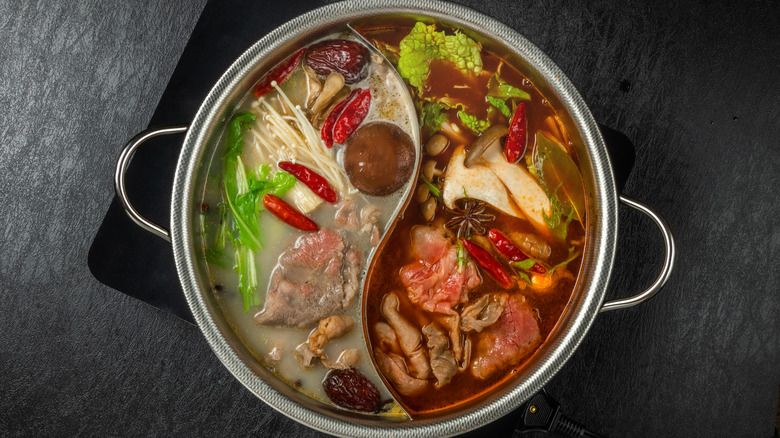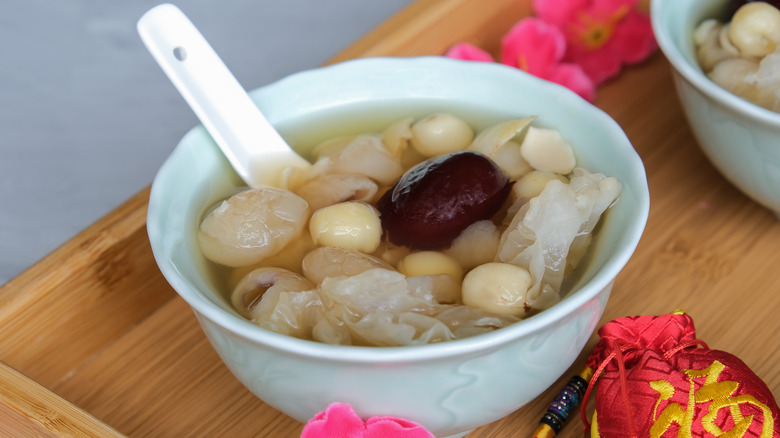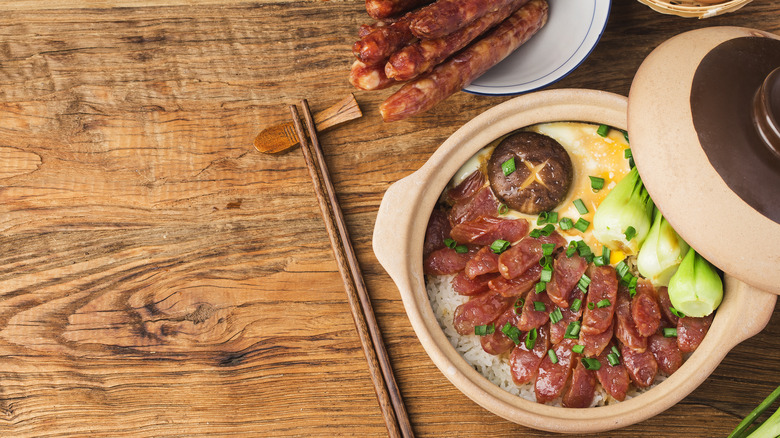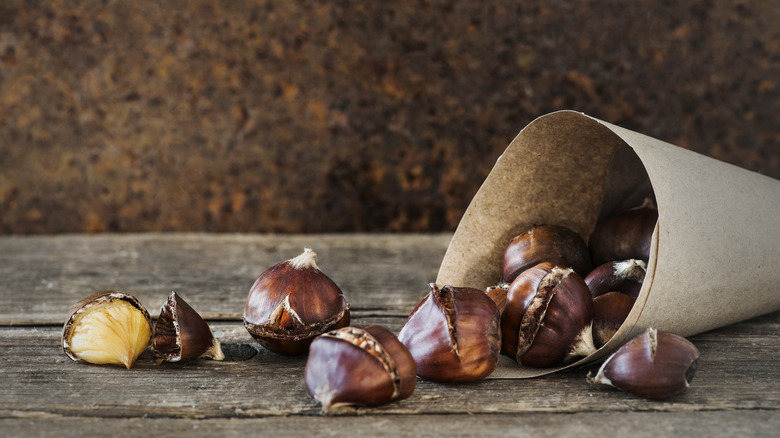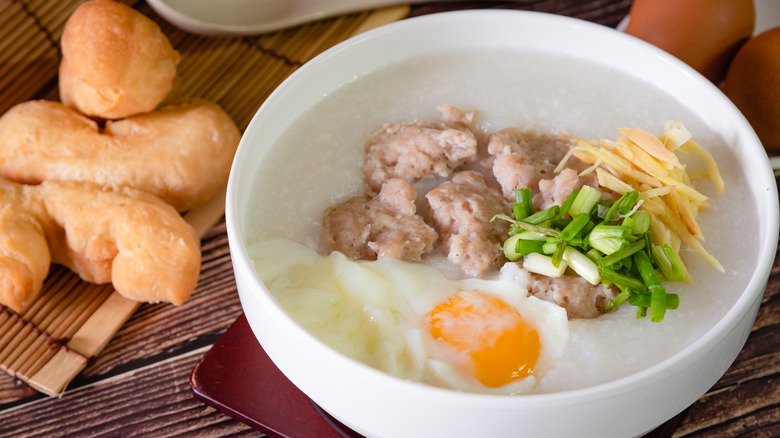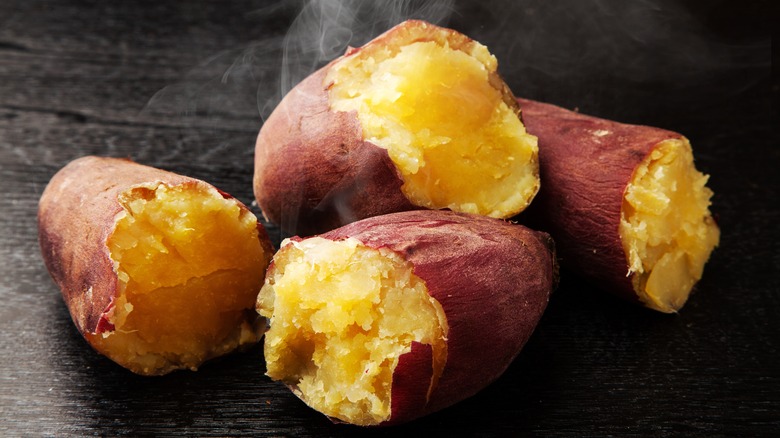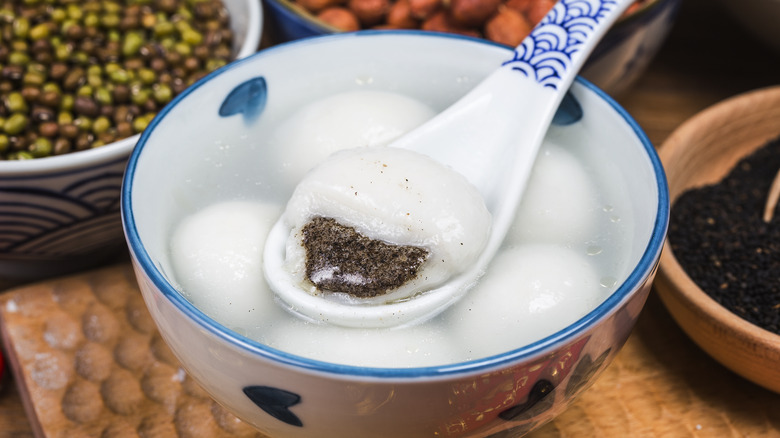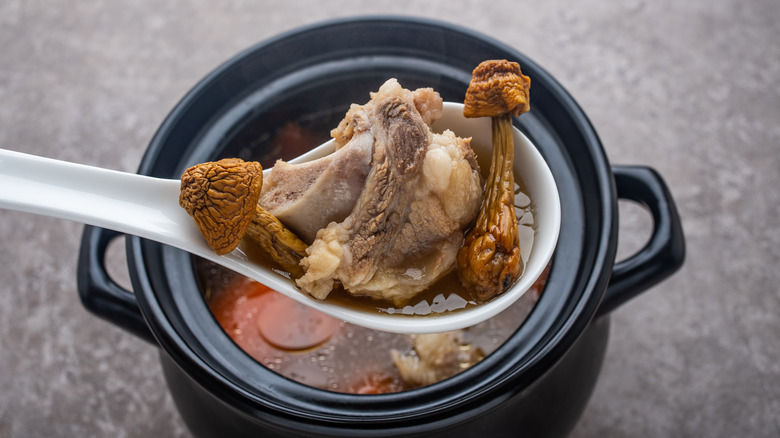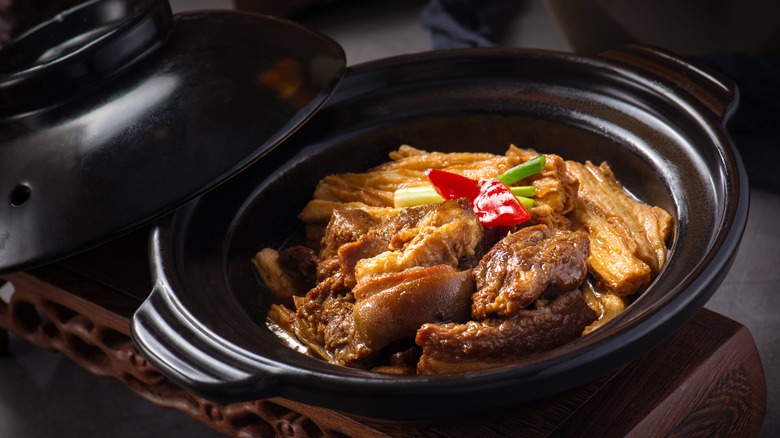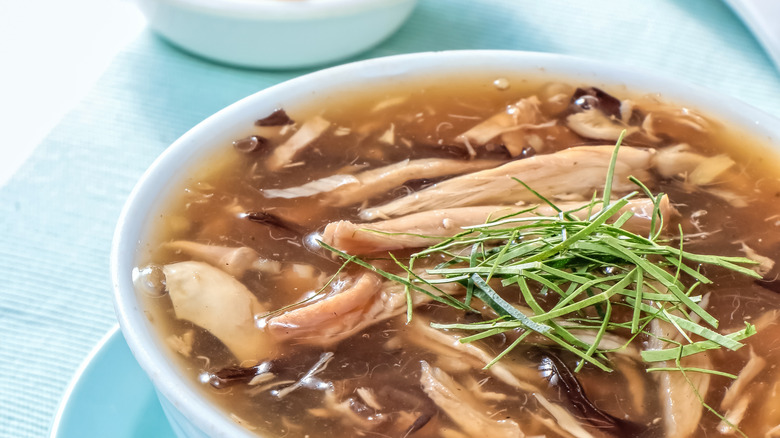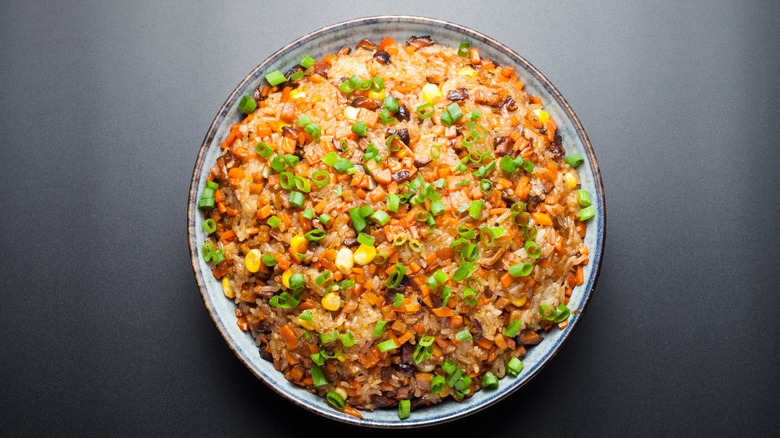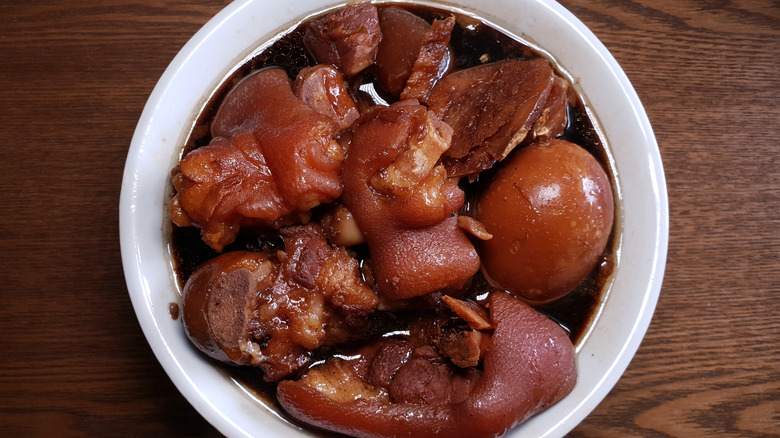12 Cantonese Winter Foods To Keep You Cozy
Many cultures around the world have a cuisine abundant in stews, soups, and teas, you name it, and the Guangdong region of China is no exception. With their vast array of regional cuisines, Chinese provinces have much to offer when it comes to winter foods, and Guangdong definitely pulls its weight.
But you may be wondering — did you say Guangdong? Guangdong is a southern province in China, and its capital, Guangzhou, was named Canton by European traders who arrived in the 3rd century (via Britannica). While the name Canton is widely known, it remains the name given to Guangzhou by Europeans, though Guangzhou's history runs much deeper than European involvement in China. Therefore, we're discussing winter foods enjoyed in Guangzhou and other parts of southern China.
Coziness is universal; when the days get shorter and the nights colder, our bodies naturally crave soups, stews, and warmth. Not sure what to make for your next dinner party or a quiet night in? No worries, we have collected some of the most irresistibly comforting Cantonese specialties from Guangzhou that are sure to keep you cozy and warm all winter.
Hot pot
Perhaps one of the best-known dishes in Guangzhou, hot pot literally translates to fire pot and is a must-have winter meal. Hot pot is thought to have originated from Mongol warriors who would communally eat from a large pot over the fire. Other theories suggest that it was created by boatmen in northern China in what is now known as the Sichuan province.
Regardless of its origins, one thing is certain. Hot pot is delicious. Consisting of a large, communal pot of simmering broth and a wide array of fresh ingredients, hot pot is genuinely a choose-your-own-adventure type of meal. It is delicious with vegetables such as cabbage, mushrooms, lotus root, and chrysanthemum greens and is not complete without some fish balls, tofu, or slices of thin meat.
Whether you have a seafood hot pot or a spicy Sichuan version, according to The Woks of Life, the only essential equipment you need is a heat source, a pot, and chopsticks — easy enough! Built on the foundation of sharing and community, hot pot is an incredible opportunity to have a comforting, delicious meal with people you care about.
Tong sui
Tong sui is a sweet soup that comes in many variations and has a history as rich as it tastes. During the wintertime in southern China, you can find tong sui made from red beans, nuts, seeds, and sweet potato, so anyone can find a variety that fits their flavor preferences. Traditional tong sui is often made from walnuts and almonds or seeds like black sesame. Long ago, tong sui made with almonds was explicitly enjoyed by the imperial family.
Tong sui is a very traditional dessert and can be enjoyed from food stalls that line the streets of major cities like Hong Kong and Guangzhou. For those who prefer a riff on traditional tong sui, you can sometimes find it with tapioca pearls simmered in a coconut or fruit soup. This type of tong sui is especially enjoyed by children and makes the classic dessert even more enjoyable to indulge in — who would complain about an additional chew?
While warm tong sui is a classic winter food, there are all-season versions that can also be eaten cold. Mung bean and seaweed tong sui is often enjoyed in the summer, while adzuki bean tong sui is usually a hearty winter staple.
Clay pot rice
Maybe the rice dish that wins for both speediness and deliciousness, clay pot rice is a meal that you do not want to miss during the winter. According to The Woks of Life, clay pot rice is preferably made with jasmine rice. This allows for the finished rice to be looser than short or medium-grain rice and ensures that the individual kernels will fall apart sufficiently when done cooking.
But what is clay pot rice? Clay pot rice is a Hong Kongese winter dish traditionally made with rice, Chinese cured sausage, and pork belly that's seasoned with soy sauce, white pepper, and fish sauce. It can also come in other variations like that offered at San Francisco's Utopia Cafe, which serves clay pot rice with duck.
Now that you are itching to make clay pot rice, here is how you do it: The key to clay pot rice is soaking the rice for an hour before you cook it. This softens the rice and shortens the cooking time. When the rice is almost done cooking, mix in your seasonings. This step is essential because it gives the rice time to absorb the umami flavors of the fish sauce and soy sauce as it finishes cooking. When the rice is done, you can mix in your toppings. While there are several topping options, a classic pork belly with Chinese sausage is an exquisite place to start.
Roasted chestnuts
Chestnuts are eaten around the world in a variety of ways, from chestnut gravy to Starbucks' Mont Blanc lattes. They are starchy, creamy, and oh-so-satisfying. In Guangzhou, the love of chestnuts is just as undeniably strong. Sold on the streets of many cities like Guangzhou, Macao, and Hong Kong, roasted chestnuts are harbingers of fall and winter. The smell of them roasting invokes feelings of coziness and warmth in many.
Food Iconic to Hong Kong explains that street vendors roast their chestnuts in large basins of hot sand. This helps the chestnut's natural nuttiness bloom and makes for a delectable winter snack. Once roasted, the chestnuts are piping hot. You must delicately and quickly peel off the thick outer skin to access the soft, creamy inside. These chestnuts are also often roasted with sugar, giving them a slight sweetness and shine. This sweetness compliments the flavor of the chestnuts beautifully and pairs with the smokey, roasted flavor to create a savory–salty celebration.
Congee
Served to children, anyone with a cold, and all throughout the winter, congee (or jook in Cantonese) is a comforting, warming dish that everyone can enjoy. The beauty of congee is in its versatility. With humble rice porridge as its base, congee can be topped with anything from your Thanksgiving leftovers to a classic soft-boiled egg. Regardless of the toppings, congee's soft texture and comforting warmth make the perfect winter breakfast to start your day nutritiously.
Today, congee is known to be made from rice, but Made with Lau explains that congee can be made from all types of grains, like millet, corn, and barley. Historically congee was eaten by all classes of people, although there are theories that it was created by the working class when they had to thin their rice out with more water.
A common misconception is that congee is eaten on Lunar New Year, but in reality, many people actually see it as a bad omen to eat congee during this time. Nonetheless, all other times of year are fair game! While it is a prominent winter food, congee is so delicious and comforting that it has a place during any season. Next time you feel under the weather, try whipping up a bowl of congee; it will make you feel restored in no time.
Roasted sweet potato
Variations of roasted sweet potatoes are devoured all over eastern Asia; Japan and Korea have their own delicious versions. The secret to these baked sweet potatoes is low and slow — low heat for a long, long time. This slow bake ensures that the sugar of the sweet potato develops into an almost caramel-like flavor.
Like roasted chestnuts, roasted sweet potatoes are enjoyed during the cold winter months throughout Hong Kong and China and are commonly sold by street vendors (via Food Iconic to Hong Kong). The potatoes are served right off of the heat in brown paper bags. Once you have one, it is up to you to make the difficult decision about whether or not to peel off the piping-hot skin right away and burn your fingers. The alternative is to wait painfully for the sweet potato to cool as your mouth waters.
Once you bite into this sweet potato, you will understand what all the hype is about. These sweet potatoes are impossibly creamy and sweet inside while maintaining a slight bite from the skin. The roasting process also accents the potatoes with a lovely smokiness, while the alluring warmth of the hot potato is comforting all on its own.
Tang yuen
Traditionally eaten during Lunar New Year, tang yuan (or tong yeun) is so delicious that it can be found in the winter months preceding the New Year. According to Delicious not Gorgeous, this delicacy is made with glutinous rice flour that is mixed with water, kneaded, and rolled into balls. These little balls can then be filled with a variety of fillings, from black sesame to bean paste to coconut. The tang yuan is then boiled in a lightly flavored broth with warming winter staples such as ginger and sweet potato.
While it is traditional to eat them filled, they are also commonly eaten plain as simple chewy dumplings. This version, called hong dou tang, can be found swimming in a sweet red bean soup. These desserts are undeniably satisfying to chew and indulge in, making them just that, an indulgence. This makes tang yuan that much more special and enjoyable when it does end up on your table.
Ching po leung
Ching po leung is a staple soup that actually comes in a sweet and salty version. However, as per The Woks of Life, the savory version is more common, especially during the cold winter months. This soup not only invokes feelings of coziness and comfort in those who eat it — and especially in those who grew up eating it — it is often a way to pass down knowledge and culture within a family. After hours of simmering at low heat, the ching po leung is rich and savory thanks to its base, beef bones.
Another reason that ching po leung is a winter staple is that many of the ingredients are dry and, therefore, shelf-stable. This means that each family can either dry their own ingredients or easily find them at a store, even in the middle of winter. Dried seafood, like dried shrimp, adds a lot of savory umami flavor, while the lotus seeds and goji berries bring a deep complexity. As with many broth-based stews, ching po leung is best eaten on the third or fourth day once the flavors have had the time to truly infuse. One final key ingredient in ching po leung is the barley, which adds a nutty bite to the soup.
Foo jook yeung yuk
Foo jook yeung yuk is lamb stew that's a favorite during the autumn and winter months because of its delicious savoriness. Eating lamb is also believed to help ward off cold, damp weather, making it perfect for winter nights. As per The Woks of Life, this Hong Kong-style lamb stew is famous in Guangzhou and celebrates, as its name suggests, lamb. A big bowl of foo jook yeung yuk will make your body feel energized, strong, and ready to take on even the coldest winters.
The best cut of lamb for foo jook yeung yuk is the breast because it cooks down so tenderly. To cook the lamb optimally, you must blanch it first and then simmer it until it is tender. Other essential ingredients in this dish are dried mushrooms, bamboo shoots, and bean threads. The combination of these ingredients creates a textural party with tender meat, chewy mushrooms, and a nice bite from the bamboo. Seasoned with oyster sauce, soy sauce, and Shaoxing wine, an essential Chinese cooking wine, the resulting foo jook yeung yuk is filling, hearty, and the perfect winter meal when served with a large bowl of fluffy rice.
Se gang
Se gang is a traditional winter stew enjoyed in Hong Kong and Guangzhou. It's made from snake meat, pork bones, chicken, and other seasonings that make it both sweet and spicy. As per Culture Trip, this stew originated in the Guangdong province around the third century, making it an oldie but a goody!
In Chinese medicine, snake meat is known as a "yang" food, meaning that it brings heat to the body. This makes se gang an obvious staple winter dish because snake meat is a welcome warming source during the cold months. To make se gang properly, it must be simmered for hours, after which it becomes thick, fragrant, and flavorful, and is the perfect way to counteract the cold "yin" of winter.
Considering fresh snake meat is preferred for se gang, making it at home is quite difficult because fresh snake meat comes from live snakes. As per Time Out, many restaurants in Hong Kong still serve this delicacy and even have trained snake handlers who are experts in all things snakes. These restaurants offer se gang with up to five types of snake meat, some of which comes from venomous snakes.
No mai fan
Eaten all year long because it is so delicious, no mai fan is a Guangzhou favorite featuring Chinese sausage, cured pork belly, and sticky rice. Made with Lau explains that no mai fan is a great winter rice dish because it celebrates pantry staples such as dried mushrooms, shrimp, and the beloved cured meats. While hard to cut through, these dried meats are worth the elbow grease. Cured pork belly adds an irresistible fattiness to the final rice dish, and the Chinese sausage brings a nice salty bite.
Once the sticky rice is cooked and all of the ingredients gathered, it is smooth sailing toward the finish line. You simply sauté your aromatics, such as the garlic and dried shrimp, and add in the rest of your ingredients, flavoring the whole dish with both dark and light soy sauce. This meal is so beloved that it has broken free from its seasonal restrictions and is happily eaten during all times of the year. Regardless, it is the perfect, comforting dish to curl up with and enjoy whenever you are in the mood for a flavor and textural delight.
Pork knuckles with ginger and vinegar
While not strictly a winter dish, pork knuckles with ginger and vinegar is a healing dish that may help regain your strength and energy (via The Woks of Life). Traditionally eaten as a postpartum meal for new mothers, it's believed that ginger and vinegar help the body's Qi, which fills the body with warmth and helps restore it back to full strength post-childbirth.
Pork knuckles with ginger and vinegar does not skimp on either of the staple ingredients. Some recipes call for a whole pound of ginger and two bottles of vinegar to make the dish even more restorative. Ginger, according to Made with Lau, helps clear the body of coolness, increases circulation, and regulates digestion. Ginger also famously helps combat nausea and contains impressive antioxidants (via Healthline).
The other big player in this dish is Chinkiang (or Zhenjiang) vinegar, a type of Chinese black vinegar. Black vinegar differs from white vinegar in its flavor and preparation, and in this dish, it is combined with sweet black vinegar, which is a specialty of the Guangdong region. Vinegar also boasts a handful of health benefits, such as aiding in digestion and relieving respiratory troubles (via Harvard Nutrition). Regardless of whether you have just given birth, this Cantonese pork knuckle stew can be enjoyed by everyone and may help your body feel more vital during the cold season.

